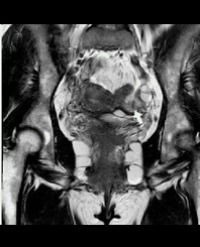
Developing a Texture Analysis Technique using Fluid-Attenuated Inversion Recovery (FLAIR) to Differentiate Tumor from Edema for Contouring Primary Intracranial Tumors
Purpose: Treatment protocols for malignant tumors generally call for surgical removal followed by tumor-bed irradiation. Irradiation ideally affects the tumor volume while limiting damage to surrounding normal tissues; this requires accurate determination of 3-D treatment volumes. Glioblastoma multiforme (GBM) and meningioma are common primary intracranial tumors. Edema surrounding meningioma is vasogenic, while edema surrounding GBM may also have tumor cell infiltration, difficult to differentiate by Fluid-Attenuated Inversion Recovery (FLAIR). Hypothetically, the FLAIR signals of edema and GBM should differ. We used T2W-FLAIR spin-echo to determine edema type and differentiate tumors through their textural properties.
Methods: Enrollment was 20 patients with GBM and 10 with meningioma. Patients were scanned using a 3-D multiecho GRE sequence, measuring the FLAIR signal of edema around the tumor. Segmentation identified two regions of interest (ROI, edema and tumor); texture analysis was applied to each ROI with- and without normalization. LASSO analysis of texture parameters selected the best parameters for separating ROIs; using them, we performed a Receiver Operating Characteristic (ROC) analysis.
Results: Two intracranial tumor types with- and without normalization provided four scenarios per ROI. First-order statistics using 1%-percentile feature was chosen in all scenarios and had the best discriminant ability for meningioma. Second-order statistics using correlation features was also selected across scenarios, although angle and magnitude varied. Higher-order statistics using short-run emphasis features and gray level non-uniformity provided the best discrimination for GBM images with- and without normalization, respectively. ROC curves display the results of both the single best discriminator and the discriminant ability of the model using all features selected by LASSO. All univariate models had good discriminant ability (AUC>0.83), and all multivariate models had excellent discriminant ability (AUC>0.92).
Conclusion: A small subset of texture parameters shows excellent ability to discriminate edema from tumor tissue through its most discriminating features.
Edward Florez1, Todd A Nichols1, Seth T Lirette2, Candace M Howard1 and Ali Fatemi1,3*

